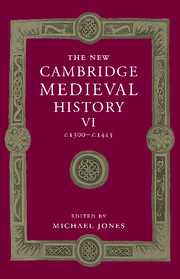Book contents
- Frontmatter
- Part I General Themes
- Part II The States of the West
- Part III The Church and Politics
- Part IV Northern and Eastern Europe
- 21 Baltic Europe
- 22 The Kingdoms of Central Europe in the Fourteenth Century
- 23 The Principalities of Rus’ in the Fourteenth Century
- 24 The Byzantine Empire in the Fourteenth Century
- 25 Latins in the Aegean and the Balkans in the Fourteenth Century
- 26 The Rise of the Ottomans
- 27 Christians and Muslims in the Eastern Mediterranean
- Appendix Genealogical Tables
- Primary Sources and Secondary Works Arranged by Chapter
- Index
- Frontispiece
- Plate section
- Map 4 Europe's trade, c. 1300
- Map 5 Europe's trade, c. 1400
- Map 7 The Hundred Years War to 1360
- Map 15 Russia, c. 1396
- Map 17 The Byzantine empire in the 1340s
- References
22 - The Kingdoms of Central Europe in the Fourteenth Century
from Part IV - Northern and Eastern Europe
Published online by Cambridge University Press: 28 March 2008
- Frontmatter
- Part I General Themes
- Part II The States of the West
- Part III The Church and Politics
- Part IV Northern and Eastern Europe
- 21 Baltic Europe
- 22 The Kingdoms of Central Europe in the Fourteenth Century
- 23 The Principalities of Rus’ in the Fourteenth Century
- 24 The Byzantine Empire in the Fourteenth Century
- 25 Latins in the Aegean and the Balkans in the Fourteenth Century
- 26 The Rise of the Ottomans
- 27 Christians and Muslims in the Eastern Mediterranean
- Appendix Genealogical Tables
- Primary Sources and Secondary Works Arranged by Chapter
- Index
- Frontispiece
- Plate section
- Map 4 Europe's trade, c. 1300
- Map 5 Europe's trade, c. 1400
- Map 7 The Hundred Years War to 1360
- Map 15 Russia, c. 1396
- Map 17 The Byzantine empire in the 1340s
- References
Summary
the fourteenth century saw the union of the crowns of central Europe. One by one, the last Přemysls, the house of Anjou in Hungary and the Luxemburgs, attempted to construct states whose national identity might have appeared threatened by the collapse of the old indigenous dynasties and the diffusion of foreign influence. These dispositions were based upon a dynastic policy of marriages, which represented a middle way between the right of conquest and the popular sovereignty of the future. In 1301, the son of Wenceslas II of Bohemia was elected king of Hungary; but he was unable to maintain his position and abdicated in 1304: exchanging the Hungarian crown of St Stephen for those of Bohemia and Poland (which his father left him) in the following year. Wenceslas III was assassinated in 1306. He was the first to occupy – admittedly in succession – the three thrones of Hungary, Bohemia and Poland.
The fourteenth century was also a kind of apogee for these states, associated in each instance with the vigorous personality of an exceptional sovereign. People like to recall that Louis of Anjou was the only king of Hungary surnamed ‘the Great’; he shared this epithet with his predecessor in Poland, Casimir. As for the Emperor Charles IV, he was the ‘father of his country’ (pater patriae) of a Bohemia in full political and cultural expansion. In each case, after succession difficulties at the beginning of the century, these long and great reigns marked a period of clear equilibrium in all fields, whether in territorial matters, political and social institutions, economic and material life or cultural developments.
- Type
- Chapter
- Information
- The New Cambridge Medieval History , pp. 735 - 763Publisher: Cambridge University PressPrint publication year: 2000
References
- 1
- Cited by



